German uniforms of the Second World War can often appear intricate and even contradictory. To shed light on this topic, especially regarding the elite German paratroopers, the Fallschirmjäger, this guide aims to clarify the variations in their uniforms during World War II.
 Men of the SS-Fallschirmjäger-Btl 500 on the airfield at Mataruška Banja
Men of the SS-Fallschirmjäger-Btl 500 on the airfield at Mataruška Banja
The Fallschirmjäger, or German paratroopers, were distinguished by their specialized jump smocks. It’s important to recognize that primarily two main styles of jump smocks were prevalent, though minor variations existed. The earliest jump smock was a “step-in” design. Typically produced in a pale greenish-grey color, this version was characteristic of the Blitzkrieg era and remained in use up to the invasion of Crete in 1941.
 Fallschirmjäger drop canister
Fallschirmjäger drop canister
Starting around 1941, these step-in smocks were also manufactured in a splinter camouflage pattern and continued to be used throughout the remainder of the war. These early smocks can be identified by their distinctive “short shorts” appearance on figures.
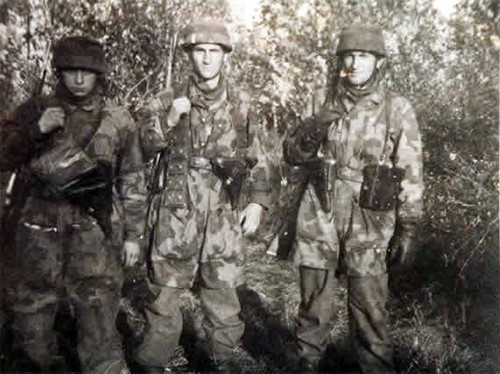 Fallschirmjäger troops in early war uniforms
Fallschirmjäger troops in early war uniforms
Around 1942, a significant redesign of the jump smock occurred. The garment transitioned from a short, one-piece “onesie” style to resemble a shorter greatcoat. This new design incorporated fastenings around the legs for secure closure when needed. Figures wearing this later smock style are recognizable by their longer, more flowing uniform silhouette. These were produced in both splinter and marsh camouflage patterns.
 Fallschirmjäger in later war marsh pattern uniforms
Fallschirmjäger in later war marsh pattern uniforms
Early War Fallschirmjäger Uniforms
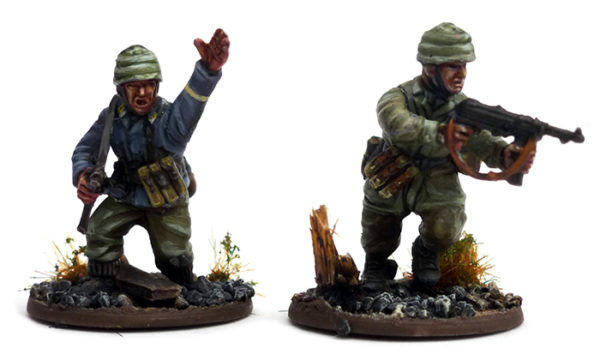 Fallschirmjäger early war uniform front view
Fallschirmjäger early war uniform front view
During the initial years of the war, from 1939 to 1941, the standard Fallschirmjäger Uniform consisted of field grey trousers, a field blue Luftwaffe tunic, and the early greenish-grey jump smock. Webbing was typically crafted from dark brown leather, though it was often dyed or polished to appear almost black. Helmets were painted in dark blue or dark green. With the commencement of the Crete invasion in 1941, splinter pattern smocks began to be issued. However, it’s crucial to note that these early war uniforms continued to be worn throughout the entire war.
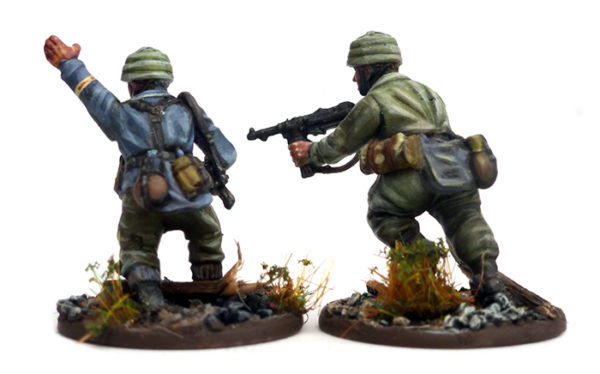 Fallschirmjäger early war uniform rear view
Fallschirmjäger early war uniform rear view
Tropical Fallschirmjäger Uniforms
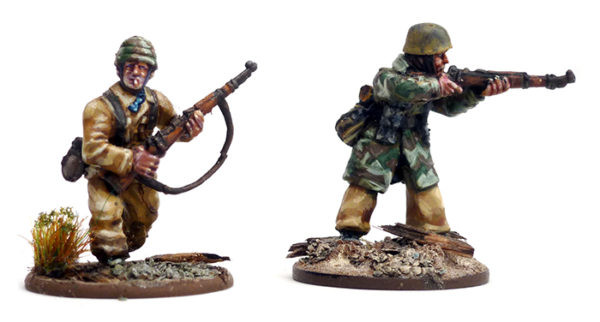 Fallschirmjäger tropical uniform front view
Fallschirmjäger tropical uniform front view
For Fallschirmjäger units deployed in hot climates, such as the Ramcke Brigade in North Africa, Tunisia, and Italy during the summer, the Luftwaffe tropical uniform was utilized. This uniform comprised a tan lightweight tunic and loose-fitting trousers. Fallschirmjäger operating in these regions commonly wore their jump smocks over the tropical uniform. The later style jump smocks also began appearing within the Ramcke Brigade, making splinter camouflage increasingly prevalent in these theaters. Like the early war uniforms, tropical uniforms remained in service in Italy until the war’s end.
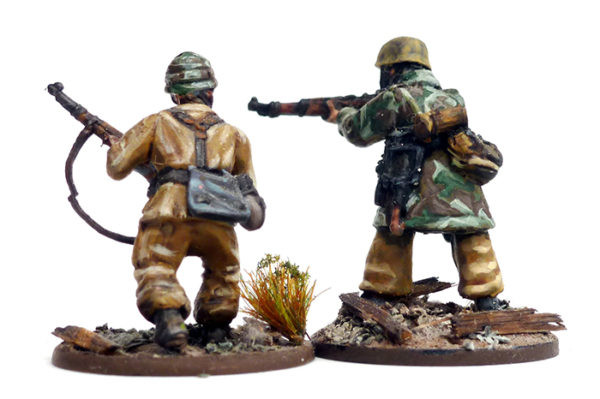 Fallschirmjäger tropical uniform rear view
Fallschirmjäger tropical uniform rear view
Camouflage Fallschirmjäger Uniforms
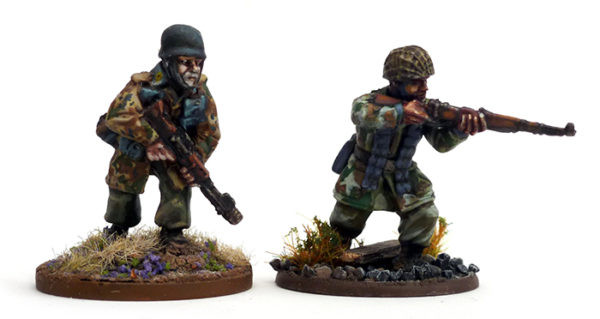 Fallschirmjäger camouflage uniform splinter pattern front view
Fallschirmjäger camouflage uniform splinter pattern front view
As previously mentioned, jump smocks were produced in two primary camouflage patterns: splinter and marsh pattern. Splinter camouflage is characterized by sharp-edged patterns of brown and green on a pale green or tan base. Marsh pattern, conversely, features softer, blended patterns of green and reddish-brown on a sand or ochre base. Splinter pattern smocks were introduced around late 1941, while marsh pattern smocks appeared in limited quantities from 1944 until the war’s conclusion.
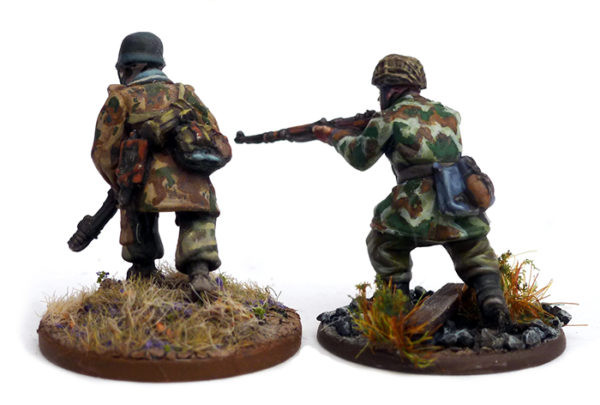 Fallschirmjäger camouflage uniform marsh pattern rear view
Fallschirmjäger camouflage uniform marsh pattern rear view
Winter Fallschirmjäger Uniforms
 Fallschirmjäger winter uniform greatcoat front view
Fallschirmjäger winter uniform greatcoat front view
During colder winter conditions, Fallschirmjäger utilized the standard Luftwaffe greatcoat, alongside reversible padded winter clothing. These padded winter suits were available in mouse grey, splinter, or marsh camouflage patterns, providing essential warmth and camouflage in snowy environments.
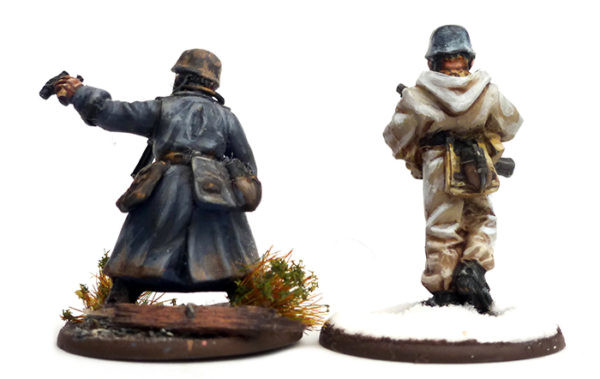 Fallschirmjäger winter padded suit rear view
Fallschirmjäger winter padded suit rear view
Foul Weather Uniforms
 Fallschirmjäger foul weather uniform Zeltbahn poncho front view
Fallschirmjäger foul weather uniform Zeltbahn poncho front view
While not strictly winter attire, the Zeltbahn poncho was a versatile piece of equipment used by Fallschirmjäger. It served multiple purposes, including breaking up the wearer’s silhouette, providing warmth and protection from rain, and functioning as makeshift camouflage. Issued to all branches of the German military, Luftwaffe Zeltbahns were produced in splinter camouflage.
 Fallschirmjäger foul weather uniform Zeltbahn poncho rear view
Fallschirmjäger foul weather uniform Zeltbahn poncho rear view
Understanding the nuances of Fallschirmjäger uniforms requires recognizing the different styles, patterns, and adaptations used throughout World War II. This guide provides a foundational overview for enthusiasts, modelers, and anyone interested in the historical accuracy of these elite German paratrooper uniforms.
 Fallschirmjäger starter army deal
Fallschirmjäger starter army deal
 Fallschirmjäger plastic box set
Fallschirmjäger plastic box set
 Fallschirmjäger paint set
Fallschirmjäger paint set
